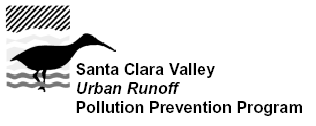Stormwater Runoff
- Vehicle Brake Pads
- Architectural Copper
- Pool/Spa/Fountain Algaecides
- Copper Pesticides
- Industrial Copper Use
- Soil Erosion
- Mobile Cleaning
- Vehicle Washing
- Vehicle Services
Discharges to POTWs
Shoreline Activities
Copper Piping Corrosion
Approximately sixty percent of the copper loading to wastewater treatment plants has been estimated to be from corrosion of copper pipe and fittings. Recent research indicates that corrosion from newly installed copper piping is five times greater than from older systems. Water purveyors adjust pH and add various chemicals to control the corrosivity of potable water to comply with Federal Safe Drinking Water Act Lead and Copper Rule requirements.
Stormwater Control Measures
Copper pipe corrosion does not impact stormwater quality.
Wastewater Control Measures
To reduce pipe corrosion
and discharges of copper to San Francisco Bay, plumbing engineers and
system designers can make simple adjustments in the design process. Design
modifications along with skilled installation and maintenance techniques
can reduce copper corrosion by as much as fifty to seventy-five percent.
Water purveyors could potentially further reduce the corrosivity of their
water supplies and thus the release of copper. However, neither POTWs
nor the Regional Water Quality Control Board have authority over the degree
to which water purveyors implement corrosion control measures beyond those
required for Lead and Copper Rule "optimization."
Best Management
Practices
Best management practices
information sources include:
California
- Good
Plumbing Practices Protect San Francisco Bay - This fact sheet
developed for installers and plumbers describes how copper pipe corrosion
impacts San Francisco Bay and provides best management practices on
how to reduce pipe corrosion.
- Preventing Corrosion Protects San Francisco Bay - This fact sheet developed for designers describes how copper pipe corrosion impacts San Francisco Bay and provides simple design adjustments and techniques on how to reduce pipe corrosion and help protect San Francisco Bay.
- City
of Palo Alto - Copper Corrosion Control (PowerPoint Presentation)
- This presentation provides information on what copper sources are
discharged to the City of Palo Alto RWQCP; causes of pipe corrosion;
and installation methods to reduce pipe corrosion.
- Palo
Alto RWQCP Copper Corrosion Control BMPs (PowerPoint Presentation)
- This presentation provides information on the causes of pipe corrosion;
methods to control corrosion; and the City of Palo Alto RWQCP's corrosion
control guidelines.
